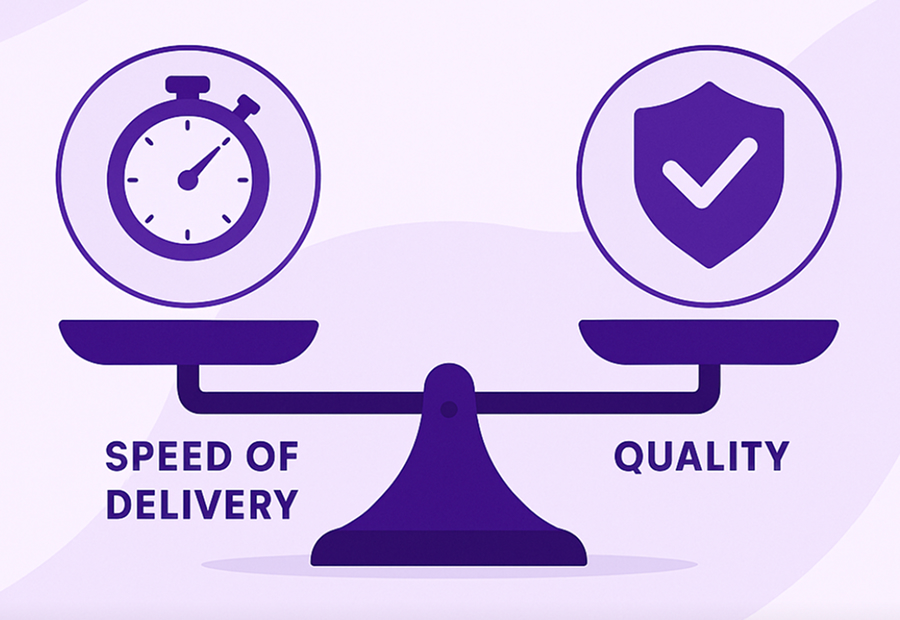Teams often struggle between fast delivery and maintaining high quality in software engineering. For example, if you quickly deliver a product with bugs, you might have to spend more time fixing them than initially planned. First-time pass rate (FTPR) is a very useful metric in such situations. It helps teams understand how often tasks are done correctly the first time.
What Is First-Time Pass Rate?
First-time pass rate (FTPR), also known as first-pass quality or first-pass yield, shows the percentage of tasks finished correctly on the first try. These tasks do not need rework or extra testing and are not sent back during peer reviews, QA testing, or user acceptance testing.

A high first-pass rate indicates that the team is doing well. A low first pass rate means there might be problems that need to be fixed.
This metric is typically used at key quality stages like code review, testing, or deployment and can be tracked in both Agile and DevOps environments. It shows how well the work is done at the beginning.
Why Is It Important?
FTPR provides visibility into process efficiency and team effectiveness. A high FTPR means that:
- Requirements were well understood from the start.
- Developers delivered code that met expectations.
- QA and testing efforts were effective.
- Communication across the team was strong.
On the other hand, a low FTPR shows problems in the process. It may mean that:
- Developers have unclear or incomplete requirements.
- Quality standards are not met.
- Code often fails testing or review.
Improving FTPR helps reduce the time spent on repeating the work. It shortens lead times and makes delivery faster without reducing quality, which boosts team morale. Developers feel better when their work moves smoothly through the process.
How to Measure FTPR
To calculate the first-pass yield, count the work items that pass a stage on the first try. Then, divide that number by the total work items that entered the stage.
FTPR = (Number of items passed first time / Total items evaluated) x 100%
This can be applied at different checkpoints, such as:
- Code review (how many pull requests are merged without rework).
- Automated testing (how many builds pass all tests the first time).
- Manual QA (how many features are accepted without defects).
- Deployment (how often deployments succeed without rollback).
Tracking this metric consistently helps identify trends and areas for improvement.
Common Causes of Low FTPR
A poor first-time pass rate can highlight several issues in your delivery process.
- Unclear or incomplete requirements: Developers start working without understanding the full requirements. This causes mistakes and results in back-and-forth corrections.
- Poor communication: When the team doesn’t work closely, the output becomes unclear. This causes more errors and leads to delays.
- Technical debt: Cutting corners to meet deadlines often affects quality. These issues must be fixed later.
- Inadequate testing: Weak automated tests or insufficient manual QA can result in defects being missed. This causes problems to be discovered late.
- Lack of code review discipline: Issues can be missed initially when reviews are not thorough or consistent.
Strategies to Improve First-Time Pass Rate
Improving FTPR needs better processes, culture, and tools. Here are ways to improve your team’s FTPR:
1. Strengthen Requirement Clarity
- Use BDD (behavior-driven development) and user story mapping.
- Involve developers early in backlog refinement. This clears up expectations.
2. Improve Team Communication
- Foster cross-functional collaboration through regular stand-ups and planning sessions.
- Encourage peer feedback during development, not just at review time.
3. Invest in Quality Assurance
- Implement robust test automation early in the development lifecycle.
- Practice test-driven development (TDD) to catch defects before they occur.
4. Standardize Code Reviews
- Define clear guidelines for reviews and enforce them.
- Use pull request templates to ensure consistency and completeness.
5. Shift Left on Testing
- Integrate QA early in the pipeline.
- Catch issues sooner by running unit, integration, and smoke tests during build stages.
6. Track and Act on Metrics
- Monitor FTPR trends over time to identify regressions.
- Pair FTPR with other metrics like lead time, deployment frequency, and defect escape rate to get a fuller picture.
What’s a Good First-Time Pass Rate?
- There is no one-size-fits-all “perfect” FTPR. It depends on the team, project complexity, and workflow.
- Many high-performing teams aim for 90% or higher. However, the main goal should be continuous improvement, not perfection.
- For example, if a team’s first pass rate is 60%, improving it to 75% is already a big step forward.
Conclusion
First-time pass rate (FTPR) is more than a quality measure. It shows how well the team communicates, reflects the maturity of the process, and shows the strength of engineering practices. FTPR can be an early sign of hidden problems. A high FTPR means the team is doing things right the first time, which is faster and more effective.
